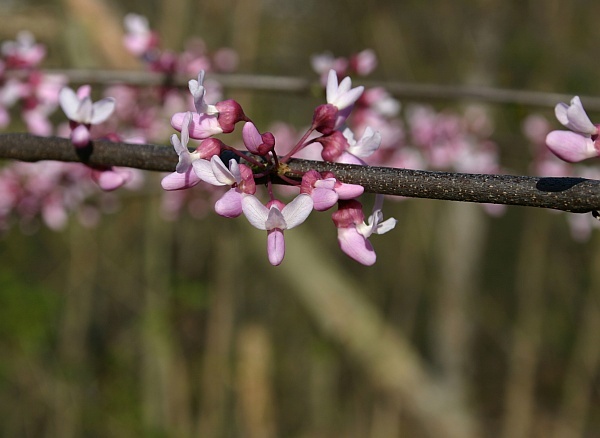
Time for a beauty break.
April showers bring May flowers. The redbud is blooming in Schenley Park.
Take a walk outdoors and savor Spring.
(photo by Kate St. John)

Time for a beauty break.
April showers bring May flowers. The redbud is blooming in Schenley Park.
Take a walk outdoors and savor Spring.
(photo by Kate St. John)
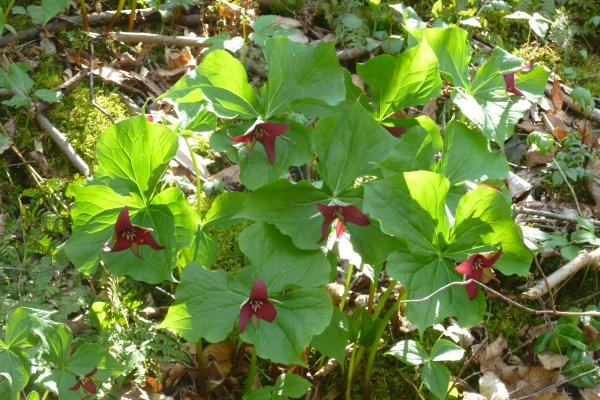
Here’s a flower with a bird’s name.
Blooming now in western Pennsylvania, the red trillium (Trillium erectum) is sometimes called wake-robin, perhaps a reference to the robin’s red breast though their colors aren’t the same.
The flowers smell like rotting meat because they’re pollinated by flies. This gives the plant another name: Stinking Benjamin. Have you ever noticed that fly-pollinated flowers are often this color?
Look for wake-robin in woodlands this weekend. Dianne Machesney found these near Monroe Road on the Butler-Freeport Trail.
(photo by Dianne Machesney)

(While we wait for the peregrine eggs to hatch, let’s look at some plants.)
I used to say with confidence that mayapples bloom in May but I got worried last year when they came out in April.
This year I saw two plants blooming in Frick Park on April 17. I started to worry again, but last weekend’s cold weather put the flowers on hold. Just to be sure I went out and checked on them.
Mayapples (Podophyllum peltatum) are perennial plants that grow in colonies in open woods. When they first come up the colonies look like miniature forests of green umbrellas.
Each plant has one or two leaves but only the two-leaved plants have flowers because the flower stalk grows from the Y between the leaves.
Above are two mayapples with single leaves in Schenley Park. Nice, but they won’t have flowers.
Below, a nascent double-leaf plant shows the flower bud between the leaves.

As the plant grows the umbrellas unfurl with the flower bud between them.

Then the bud turns its head downward and the flower opens vertically or face down. The leaves are so big and shady that it’s hard to see the flower.
Schenley Park’s mayapples weren’t blooming yet (aha!) so I found a picture of a blooming plant on Wikimedia Commons. It’s on a hill so the photographer can look up to see the flower.
If you really want to see mayapple flowers up close you have to lie on your belly to do it.
I’m sure that’s what Chuck Tague did to get this photo. I’m leaving the dirty work to him.

A week from today will be May 1. Unless the weather heats up really fast, I think it’s safe to say these will be “May” apples this year.
(leaf and bud photos by Kate St. John. complete flowering plant from Wikimedia Commons. Flower closeup by Chuck Tague.)

Every spring I’m stumped by this small flower that blooms in lawns, fallow gardens and waste places. With four petals and alternate “divided” leaves I could tell it’s in the Mustard family. When I keyed it out in Newcomb’s Wildflower Guide I arrived at Pennsylvania bittercress (Cardamine pensylvanica*).
But that’s not what it is. It grows too well in poor soil to be a plant known for preferring wet habitats, swamps and stream banks. I began to suspect it’s an alien.
Based on that hunch I sent photos to friends. Mark Bowers answered that this is hairy bittercress (Cardamine hirsuta), native to Europe and Asia.
Like Pennsylvania bittercress, its young leaves can be used in salads and are said to taste like radishes.
(photo by Kate St. John)
* Not a typo, the person who classified Cardamine pensylvanica omitted the second ‘n’ in our state’s name.
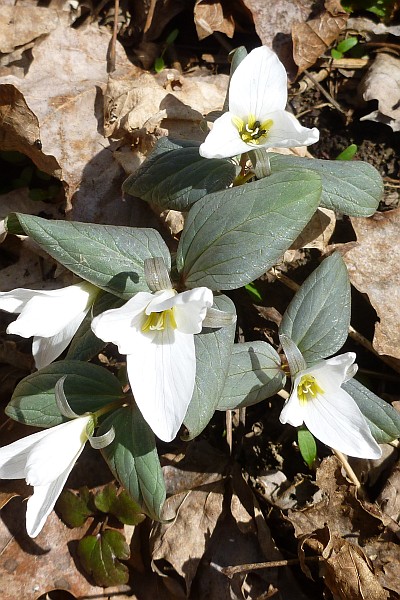
Yesterday I wrote about coltsfoot but it’s not the first native wildflower to bloom in western Pennsylvania. That honor goes to snow trillium (Trillium nivale).
I looked for snow trillium last weekend at Raccoon Creek Wildflower Reserve and found the leaves but the deer had eaten all the flowers.
Dianne and Bob Machesney found these blooming at Cedar Creek Park in Westmoreland County.
Thankfully there are fewer deer at Cedar Creek.
(photo by Dianne Machesney)
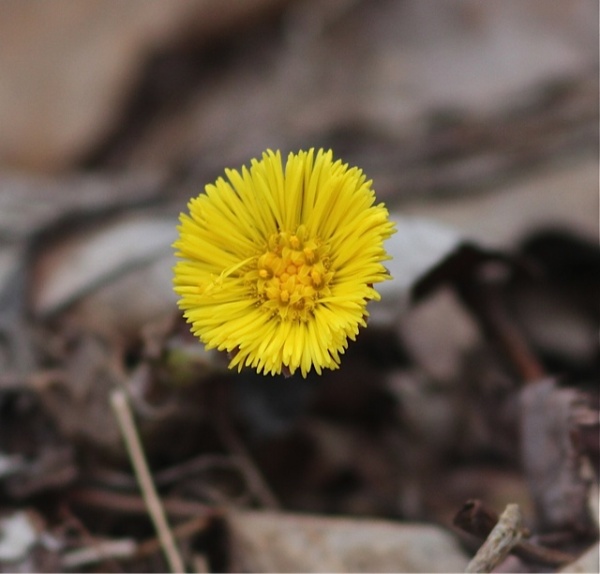
At last I’ve found coltsfoot blooming. Spring is officially here.
Coltsfoot is an introduced plant that blooms earlier than most of our native wildflowers. It’s not picky about habitat so you’ll find these dandelion-like flowers by the side of the road and in waste places.
When you see the flower you won’t see the leaves. They’re hidden at the base of the plant right now but will grow into large colts’- foot-shaped leaves after the flowers are gone.
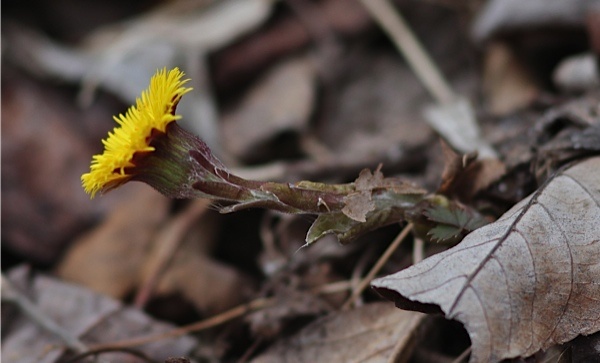
Normally I find coltsfoot blooming around March 25. In last year’s hot weather it appeared on March 14. You can see why I’m impatient.
At last!
(photos by Marcy Cunkelman)
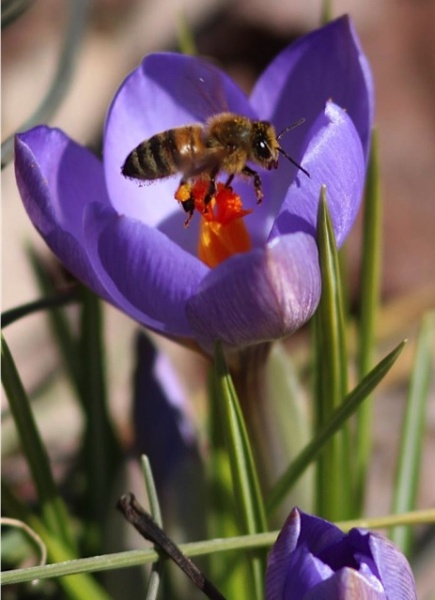
Easter is early, winter is late. Few flowers are blooming in western Pennsylvania.
This weekend my surviving crocuses opened fully to receive a visit from a honeybee. He emerged with pollen pantaloons just like this bee in Marcy Cunkelman’s garden.
The bees are happy to find flowers this Easter Day.
(photo by Marcy Cunkelman)
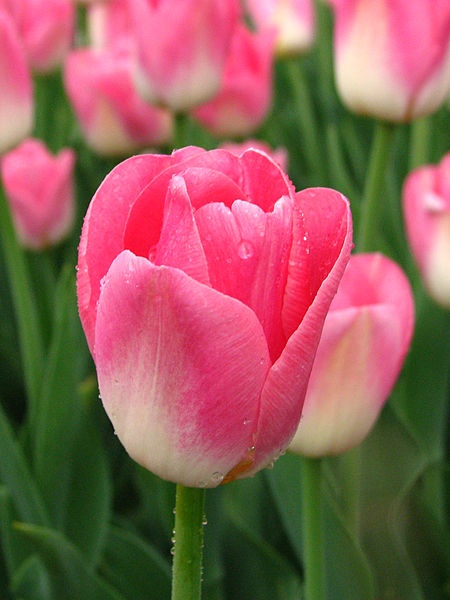
25 March 2013: Snow again! We are so ready for spring here in Pittsburgh.
The crocuses bloomed early last week but were slammed shut on Wednesday by a low of 200F. Daffodil leaves emerged and paused. Don’t even ask about tulips.
But Spring is south of us and it’s on its way. There’s a rule of thumb that says Spring moves north 13 miles a day.
Here’s an easy way to watch its progress.
Journey North has a Tulip Test Garden website where observers report when leaves emerge and flowers bloom from the tulip bulbs they planted last fall. Many of the tulip gardens are student projects at elementary schools such as Della Kurtzhals’ class at Clarion Area Elementary School in Clarion, PA.
So how far away is spring? At Providence Day School in Charlotte, NC the first tulip bloomed on March 18. Using the rule of thumb, here’s my guess at blooming times in Pittsburgh and Clarion:
This is just an estimate. Actual blooming times may vary. I won’t be charged like Punxsutawney Phil was for “misrepresenting spring.” (Click here to read about the charges made against him in Hamilton, Ohio. The comments are hilarious.)
So while your garden is covered in snow, rest assured that spring is moving north. You can see it approaching on the Tulip Test Garden map.
(photo from Wikimedia Commons. Click on the image to see the original)
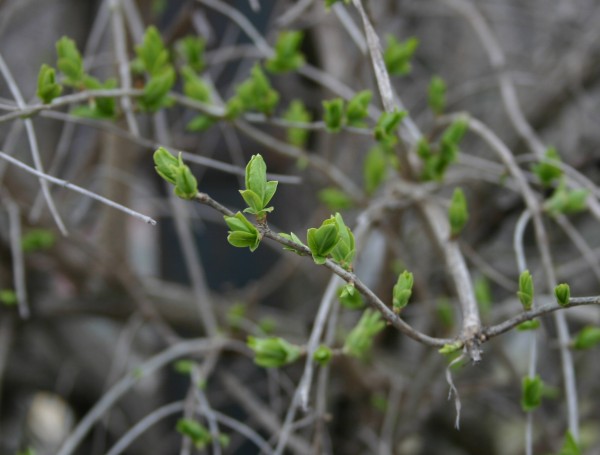
Just in time for St. Patrick’s Day…
The first plant to open leaves in my neighborhood is always the invasive bush honeysuckle across the street. Though I’m not fond of the species I’m always happy to see these particular bushes green up. They’re one of my signs of Spring.
Yesterday, March 15, was the first time the leaves were green enough to see at a distance.
A year ago the hot weather put us well beyond honeysuckle leaves and into magnolia flowers by this date.
Here’s a picture from March 16,2012.
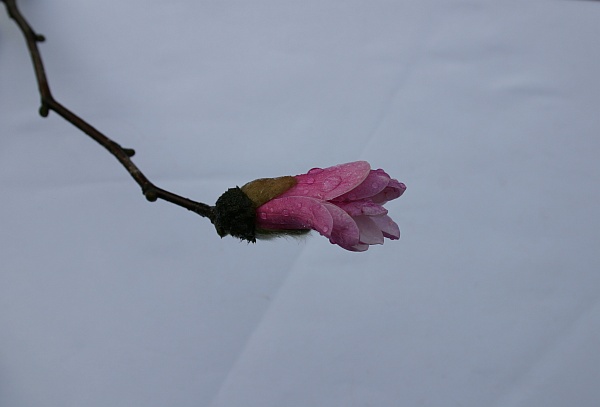
Frankly, I’m quite happy we’re having a normal spring.
(photos by Kate St. John)

18 December 2012
It’s poinsettia time so I went online to look for a pretty picture. That’s when I got into trouble.
I searched Wikimedia Commons for poinsetta and found only four pictures. Huh? Only 4? That cannot be possible.
One of the photos pointed to another view of the same plant and I finally got the hint. I was spelling it the way I pronounce it — poin SET ah — without the second “i.” I was spelling it wrong.
Poinsettias are native to Mexico where they are very leggy plants in the wild. They were named for Joel Roberts Poinsett, first U.S. Minister to Mexico, who brought them to the U.S. in 1825.
The plant became popular as a Christmas decoration when Albert Ecke became fascinated by them, his son learned to make them into bushier, more beautiful plants, and his grandson promoted them on television in the 1960’s. The rest is history.
Meanwhile, I was shocked — shocked! — to discover that there are two i’s in poinsettia and the second “i” should (or could) be pronounced. I have never pronounced that second “i” and I wondered if this was a ‘Burgh thing (we have a notoriously vowel poor accent) so I conducted an informal poll.
How do you say the name of this plant?
So far, everyone I’ve asked says poin-SET-ah (no second “i”). Two people knew about the extra “i” and one of them changed her pronunciation after she learned about it — but she didn’t start out that way.
I’ve heard that in some parts of the U.S. people say poin-SET-tee-ah, but if you’re from the Pittsburgh, well… Poinsetta.
Hah! No wonder I misspelled it.
(photo by André Karwath on Wikimedia Commons. Click on the image to see the original)